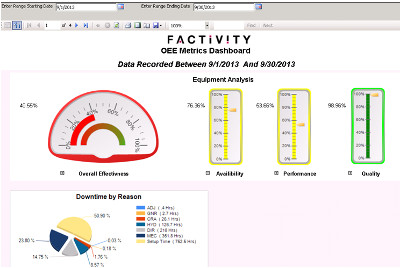Metrics, a measurement methodology, are being used frequently in today’s manufacturing environment as the pathway to best practices and world class manufacturing. The use of information, specifically data collected during the production process, is not a new idea. However when it comes to the factory floor, most of the prior data collection projects in many manufacturing facilities focused on accounting information and not process information. In other words, instead of collecting labor time on the job (which means labor time spent working at a work center), manufacturers today are looking into measures that can help improve the speed of delivery of product through the factory, which is sometimes referred to as “flow” time and includes both the “value add” time (time working on a part at the work center) but also the queue or wait time. FACTIVITY, a software product specifically to improve efficiency on the factory floor, measures all the jobs from time of release of the product/part into the production facility until the time of completion of the last operation in the routing manufacturing process.
Measuring the floor time in an efficient and effective manner can be a complement to labor time collection when using a robust Manufacturing Executions System (MES) like FACTIVITY. FACTIVITY can be used to collect both operational problems that might cause a delay in flow time as well as the non-operation time (time spent waiting in a “queue” state) before each operation. Both of these time components can and should be evaluated when focusing on improving on the metric goal of “on-time delivery”.
However, before any improvement can be realized using metrics, a decision has to be made regarding management’s commitment to using measurement as a way to accomplishing an objective; in this case the objective of improving the on-time delivery. This commitment must include a person who will be committed to the management of Process Improvement. This individual must have authority, time and knowledge if a company truly want to use metrics as a way to improve your process. This person must have:
- The AUTHORITY to make decisions in process improvements
- The TIME to hold weekly meetings with key manufacturing personnel
- The KNOWLEDGE and willingness to work with the data collected by FACTIVITY
Most likely in your manufacturing facility you have a person in charge of managing the material; this materials manager will focus on inventory levels, purchase order processing, vendor commitments, etc. In the same way, the Process Manager is focused on queue time tracking, operational efficiency and inefficiency, goal attainment, etc.

MES Myths and Mistakes …
Not knowing about the issues surrounding this technology can cost your factory plenty!
The Metrics provided by FACTIVITY come in several types. The KPI Metrics Module is developed in Microsoft Reporting Services. In additional there is an easy way to export process related information captured in real-time on the factory floor into Excel Spreadsheets for “user friendly” evaluation.
There are a few steps needed to use any or all of these reporting (Metrics) tools in a useful and productive manner. As mentioned above once a person of authority (Process Manager) is in place then he/she can set-up their own approach to using our data. Part 2 of this article will expand on this topic by outlining one suggested approach used as an example of applying metrics to performance improvements.

Once a Process Improvement Manager is in place and working regularly on attacking wasted (non-value added time), the OEE Metrics Dashboard (below) can help identify irregularities that might otherwise be undetected and also provide the basis for Plant-to-Plant performance comparisons.
Lastly, the KPI Metrics provided by FACTIVITY are focused on providing Metrics from a single production facility. However, it might be useful for Corporations that have multiple plants to have a “consolidation” data base, or data warehouse that will allow the comparison of one plant to another. Click here for additional information on this topic.
FACTIVITY’s Manufacturing Execution Software (MES) collects data from the factory floor and provides metrics needed to implement lean manufacturing practices. The system monitors equipment availability, performance and quality to visually display Overall Equipment Effectiveness (OEE) in real-time and integrates fully with your ERP system.
